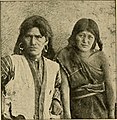File:Image from page 579 of "Bulletin" (1901).jpg

Original file (836 × 860 pixels, file size: 242 KB, MIME type: image/jpeg)
Captions
Captions
Summary edit
| DescriptionImage from page 579 of "Bulletin" (1901).jpg |
English: Title: Bulletin
Identifier: bulletin3011907smit Year: 1901 (1900s) Authors: Smithsonian Institution. Bureau of American Ethnology Subjects: Ethnology Publisher: Washington : G. P. O. Contributing Library: Smithsonian Libraries Digitizing Sponsor: Smithsonian Libraries View Book Page: Book Viewer About This Book: Catalog Entry View All Images: All Images From Book Click here to view book online to see this illustration in context in a browseable online version of this book. Text Appearing Before Image: 562 HOPI [B. A. E. from the Rio Grande, and Shipaulovi, founded by a colony from Shongopovi on the Second or Middle mesa, are both of comparatively modern origin, having been established about the middle of the 18th century, or about the time the Pay- upki people returned to their old home. Thus the pueblos of the ancient province of Tusayan now consist of the following: Walpi, Sichomovi, and Hano, on the First or East mesa; pop. (1900) 205, 119, and 160, respectively, exclusive of about 20 who have established homes in the plain; total 504. Mishongnovi, Shongo- povi, and Shupaulovi, on the Second or Middle mesa; estimated pop. 244, 225, and 126; total 595. Oraibi, on the Third or West mesa; pop. (1890) 905. Total Hopi population (1904) officially given as 1,878. Social organization.—The Hopi people are divided into several phratries, con- sisting of numerous clans, each of which preserves its distinct legends, ceremonies, and ceremonial paraphernalia. Out of Text Appearing After Image: HOPI MAN AND wife; PUEBLO OF MISHONGNOVI. (vROMAN, Photo.) these clan organizations have sprung religious fraternities, the head-men of which are still members of the dominant clan in each phratry. The relative im- portance of the clans varies in different pueblos; many that are extinct in some villages are powerful in others. The 12 phratries and their dependent clans as represented in the East Mesa villages are as follows: 1. A la-Lengy a (Horn-^nte) phratry: Ala (Horn), Pangwa (Mountain sheep), So- wiinwa(Deer), Chubio(Antelope), Chaiz- ra (Elk), Lehu (Seed grass), Shiwanu (Ant), Ann (Red-ant), Tokoanu (Black- ant), Wukoanu (Great-ant), Leliotu (Tiny-ant), Shakwalengya (Blue flute), Masilengya (Drab or All-colors flute). 2. Patki (Water-house or Cloud) phra- try: Patki (Water-house), Kau (Corn), Omauwu (Rain-cloud), Tanaka (Rain- bow), Talawipiki (Lightning), Kwan (Agavej, Siwapi ('Rabbit-brush'), Pa- wikya (aquatic animal [Duck]), Pakwa (Frog), Pavatiya (Tadpole), Murzibusi (Bean), Kawaibatunya (Watermelon), Yoki (Rain). 3. Clma (Snake) phratry: Chua (Snake), Tohouh (Puma), Huwi(Dove), Ushu(Co- lumnar cactus), Puna (Cactus fruit), Yungyu (Ojiuntia), Nabowu (Opuntia frutescens), Piuwani (Marmot), Pihcha (Skunk), Kalashiayu (Raccoon), Tubish (Sorrow), Patung (Squash), Atoko (Crane), Kele (Pigeon-hawk), Chinunga (Thistle). The last 5 are extinct. 4. Pakab (Reed) phratry: Pakab (Reed), Kwahu (Eagle), Kwayo (Hawk), Koyonya (Turkey), Tawa (Sun), Paluna (Twin-brotherof Puhukonghoya), Shohu (Star), Massikwayo (Chicken-hawk), Kahabi (Willow), Tebi (Greasewood). 5. KoJcop (Wood) phratry: Kokop (Wood), Ishauu (Coyote), Kwewu (Wolf), Sikyataiyo (Yellow-fox), Le- taiyo (Gray-fox), Zrohona (small mam- -.aal), Masi(Masauu, dead, skeleton. Ruler of the Dead), Tuvou (Pinon), Hoko (Juniper), AwatafBow), Sikyachi (small yellow bird), Tuvuchi (small red bird). 6. Taho (Cottontail rabbit) phratry: Tabo (Cottontail rabbit), Sowi (Jackrab- bit). 7. Tuwa (Sand or Earth) phratry: Ku- kuch, Bachipkwasi, Nananawi, Moniobi (varieties of lizard), Pisa (White sand), Tuwa (Red sand), Chukai (Mud), Sihu (Flower), Nanawu (small striped squir- rel). 8. Honau (Bear) phratry: Honau (Bear), Tokochi (Wild-cat), Chosro (Blue-bird), Kokvan (Spider), Hekpa (Fir). 9. Kachina (Sacred dancer) phratry: Kachina (Sacred dancer), Gyazru (Paro- quet), Angwusi (Raven), Sikyachi (Yel- low bird), Tawamana (Blackbird), Salabi (Spruce), Suhubi (Cottonwood). 10. Asa (Tansy mustard) phratry: Asa (Tansy mustard), Chakwaina (Black- earth Kachina), Kwingyap (Oak), Hos- boa (Chapparal cock), Posiwu (Magpie), Chisro (Snow-bunting), Puchkohu (Boomerang rabbit-stick), Pisha (Field- mouse ). 11. Piha (Tobacco) phratry: Piba (To- bacco), Chongyo (Pipe). 12. Honani (Badger) phratry: Honani (Badger), Muinyawu (Porcupine), Wish- oko (Turkey-buzzard), Bull (Butterfly), Buliso (Evening Primrose), Kachina (Sacred dancer). Most of the above clans occur in the other Hopi pueblos, but not in Hano. There are a few clans in the Middle Mesa Note About Images Please note that these images are extracted from scanned page images that may have been digitally enhanced for readability - coloration and appearance of these illustrations may not perfectly resemble the original work. |
| Date | |
| Source | https://www.flickr.com/photos/internetarchivebookimages/20238846478/ |
| Author | Internet Archive Book Images |
Licensing edit
| This image was originally posted to Flickr. Its license was verified as "Flickr-no known copyright restrictions" by the UploadWizard Extension at the time it was transferred to Commons. See the license information for further details. |
This image was taken from Flickr's The Commons. The uploading organization may have various reasons for determining that no known copyright restrictions exist, such as: No known copyright restrictionsNo restrictionshttps://www.flickr.com/commons/usage/false
More information can be found at https://flickr.com/commons/usage/. Please add additional copyright tags to this image if more specific information about copyright status can be determined. See Commons:Licensing for more information. |
File history
Click on a date/time to view the file as it appeared at that time.
| Date/Time | Thumbnail | Dimensions | User | Comment | |
|---|---|---|---|---|---|
| current | 01:50, 24 October 2017 |  | 836 × 860 (242 KB) | Slowking4 (talk | contribs) | User created page with UploadWizard |
You cannot overwrite this file.
File usage on Commons
There are no pages that use this file.
File usage on other wikis
The following other wikis use this file:
- Usage on lt.wikipedia.org